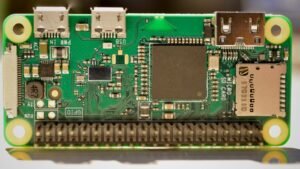AI Applications Used in Education
Artificial Intelligence (AI) technology is revolutionizing various industries, including education. With the ability to process and analyze massive amounts of data, AI provides educators and learners with innovative tools and resources that enhance the teaching and learning experience.
Key Takeaways:
- AI is transforming education by providing personalized learning experiences.
- AI applications in education include intelligent tutoring systems, grading and assessment tools, and virtual teachers.
- AI-powered chatbots help students and teachers with various educational tasks.
- Ethical considerations and data privacy are crucial when implementing AI in education.
AI offers numerous applications that benefit educators and learners alike. Intelligent tutoring systems leverage AI algorithms to provide personalized feedback and support to students, tailoring instruction to their individual needs and pace. These systems analyze student performance and adapt the learning experience, resulting in improved outcomes. *By incorporating AI, students receive targeted guidance that caters to their unique learning styles and challenges.*
Another application of AI in education is the use of grading and assessment tools. AI algorithms can efficiently and accurately assess student work, saving educators valuable time. These tools provide constructive feedback, helping students understand their strengths and weaknesses. *With AI-powered grading, teachers can focus more on developing instructional strategies and delivering engaging content.*
| AI Application | Use Case |
|---|---|
| Intelligent Tutoring Systems | Personalized instruction and feedback based on individual student needs. |
| Grading and Assessment Tools | Efficient and accurate evaluation of student work with instant feedback. |
Virtual teachers are another innovative AI application in education. These AI-powered agents provide interactive and dynamic virtual instruction, engaging students in immersive learning experiences. Virtual teachers can adapt their teaching style based on student responses and provide additional support when needed. *By leveraging AI, virtual teachers offer a scalable solution to address the growing demand for quality education.*
AI-powered chatbots are also becoming more prevalent in educational settings. These AI assistants can answer student questions, provide learning resources, and assist with administrative tasks. Chatbots offer immediate support, ensuring students and teachers have access to valuable information and assistance around the clock. *The use of chatbots enhances efficiency and productivity in educational institutions.*
| Benefit | Description |
|---|---|
| Personalized Learning | Customized instruction based on individual student needs and preferences. |
| Efficient Grading | Quick and accurate assessment of student work, saving time for educators. |
| 24/7 Support | Immediate access to resources and assistance through AI-powered chatbots. |
Implementing AI in education comes with ethical considerations. Data privacy is of utmost importance, as AI systems collect and analyze vast amounts of student data. Safeguarding this information and ensuring its appropriate use is crucial for maintaining trust in the educational environment. Additionally, it is important to address biases in AI algorithms to ensure fairness and avoid reinforcing existing inequalities. *By addressing these ethical concerns, AI can truly enhance the educational experience while respecting individual privacy and promoting equity.*
Future of AI in Education
- AI will continue to drive personalized learning experiences.
- Integration of AI will become more prominent in educational institutions.
- AI will support educators in developing adaptive and inclusive teaching strategies.
The future of AI in education looks promising. As technology advances, AI will continue to shape and enhance the way we teach and learn. It will empower students with personalized learning experiences and support educators in creating more adaptive and inclusive classrooms. By leveraging AI intelligently and addressing ethical concerns, we can unlock the full potential of AI in education.
| Development | Description |
|---|---|
| Advanced Personalization | Deeper understanding of individual student learning needs and preferences. |
| Expanded Use of AI Tools | Greater integration of AI technologies in educational institutions. |
| Adaptive Teaching Strategies | AI supporting educators in designing adaptive and inclusive teaching methods. |

Common Misconceptions
AI Applications Used in Education
There are several common misconceptions surrounding the use of AI applications in education. Many people may have inaccurate beliefs about how AI is implemented and its impact on the learning process. It is important to address these misconceptions to gain a better understanding of the potential benefits and limitations of AI in education.
- AI replaces human teachers: One common misconception is that AI in education completely replaces human teachers. In reality, AI is designed to support and enhance the teaching process, not replace it. AI can assist teachers by providing personalized learning opportunities, analyzing data, and identifying areas where students may need additional help.
- AI hinders human interaction: Another misconception is that AI applications hinder human interaction in the classroom. While it is true that AI can automate certain administrative tasks, it can also enable more personalized interactions between teachers and students. AI can provide instant feedback, adaptive learning experiences, and opportunities for collaboration.
- AI only benefits advanced learners: Some people believe that AI applications in education only benefit advanced learners. However, AI can be tailored to the needs of individual students at all levels. It can offer personalized guidance and support to struggling students, helping them catch up and improve their understanding of the material.
Furthermore, many people have misconceptions about the reliability and accuracy of AI applications in education. It is essential to address these concerns to ensure that AI is utilized effectively and ethically in educational settings.
- AI is always accurate: One common misconception is that AI applications are always accurate in assessing student performance. While AI algorithms can provide valuable insights, they are not flawless. It is crucial for educators to have a deep understanding of how AI works, be aware of its potential limitations, and exercise their professional judgment alongside AI-assisted recommendations.
- AI is biased: Another misconception is that AI applications in education are inherently biased. While AI can inadvertently amplify existing biases in data, it’s important to remember that bias can be addressed and mitigated through proper training and ongoing evaluation of AI systems. Educators should actively participate in shaping and refining AI algorithms to ensure fairness and equity.
- AI replaces critical thinking: Some individuals may mistakenly believe that AI applications hinder the development of critical thinking skills. However, AI can provide valuable tools and resources that support critical thinking and problem-solving. AI applications can present students with real-world scenarios, complex challenges, and opportunities for creative problem-solving.
By dispelling these misconceptions, it becomes evident that AI has the potential to revolutionize education by augmenting and enhancing teaching practices, promoting personalized learning, and fostering critical thinking skills.
- AI supports educators: Counter to the misconception, AI is designed to support and empower educators, providing them with valuable insights, personalized tools, and time-saving assistance.
- AI promotes inclusion: Contrary to popular belief, AI applications can promote inclusion by tailoring learning experiences to suit the needs of diverse learners, including those with different learning styles, abilities, and preferences.
- AI enhances efficiency: Rather than hindering productivity, AI applications streamline administrative tasks, allowing educators to focus more on teaching and individual student support.

Introduction
In recent years, Artificial Intelligence (AI) has made significant strides in various industries, and the field of education is no exception. AI applications are revolutionizing the way students learn, teachers instruct, and educational institutions operate. In this article, we will explore ten fascinating examples of AI applications used in education, showcasing their potential to enhance personalized learning, improve administrative efficiency, and support academic success for all learners.
AI Tutoring Systems
AI tutoring systems utilize machine learning algorithms to provide personalized and adaptive learning experiences to students. These systems can analyze student data, identify knowledge gaps, and offer targeted feedback and recommendations.
| Feature | Benefit |
|———————|————————————————————–|
| Individualized | Tailors instruction to the specific needs of each learner |
| Immediate feedback | Enables students to correct mistakes in real-time |
| Adaptability | Increases learning efficiency by adjusting difficulty levels |
| Continuous support | Offers 24/7 assistance and guidance to students |
Automated Essay Scoring
Automated essay scoring utilizes natural language processing and machine learning to assess and grade student essays without human intervention, providing fast and consistent feedback.
| Advantage | Enhanced Learning Experience |
|—————————-|———————————————————————|
| Quick feedback | Instantly provides students with valuable insights on their writing |
| Objective evaluation | Removes potential biases associated with manual grading |
| Consistency in assessments | Ensures fair evaluation and helps teachers save time |
| Constructive suggestions | Offers detailed recommendations for improvement |
Virtual Reality (VR) and Augmented Reality (AR) in Education
VR and AR technologies bring immersive experiences and visualizations to the classroom, helping students better understand complex concepts and enhancing engagement.
| Application | Benefits |
|——————-|———————————————————————————————-|
| Virtual field trips | Allows students to explore distant historical sites, museums, and natural wonders in 3D |
| Anatomy visualization | Lets students examine the human body and its systems in an interactive and realistic manner |
| Simulations and models | Enables hands-on learning experiences in physics, chemistry, and other scientific subjects |
| Language learning | Facilitates language acquisition by providing an interactive environment for practice |
AI-based Personalized Curriculum
AI can analyze student’s strengths, weaknesses, and learning style to create personalized curricula that adapt to their individual needs and interests.
| Aspect | Benefits |
|———————-|———————————————————————————|
| Mastery-based learning | Allows students to progress at their own pace and focus on areas needing improvement |
| Engagement | Motivates and increases student participation by tailoring content to their interests |
| Higher achievement | Helps students reach their learning goals more effectively and efficiently |
| Real-world relevance | Aligns curriculum with students’ skills and requirements of future job market |
Smart Content Recommendation Systems
AI-powered recommendation systems analyze students’ learning patterns, preferences, and performance to provide personalized suggestions for additional study materials.
| Benefits | Impact |
|————————————–|—————————————————————-|
| Targeted learning resources | Improves students’ access to relevant and engaging content |
| Supplementary materials | Expands students’ knowledge beyond traditional textbooks |
| Varied learning formats | Supports different learning styles and preferences |
| Bridging knowledge gaps | Helps students reinforce their understanding of challenging concepts |
Intelligent Learning Management Systems
Intelligent Learning Management Systems utilize AI to streamline administrative tasks, track students’ progress, and personalize the learning experience.
| Features | Benefits |
|———————————–|———————————————————-|
| Automated assessments | Reduces teacher workload and provides timely feedback |
| Student progress tracking | Allows teachers to identify areas for improvement |
| Resource recommendations | Assists educators in selecting appropriate learning materials |
| Data-driven insights | Offers valuable analytics to enhance teaching strategies |
AI-powered Language Learning Platforms
AI-based language learning platforms utilize natural language processing and interactive chatbots to improve language proficiency.
| Advantages | Positive Outcomes |
|———————————-|——————————————————-|
| Real-time language practice | Enhances oral and written communication skills |
| Intelligent error correction | Helps students identify and correct language mistakes |
| Personalized learning journeys | Adapts content to individual language levels |
| Cultural immersion | Provides insights into different cultures and customs |
Smart Attendance Systems
Smart attendance systems utilize AI and facial recognition technologies to automate and streamline attendance tracking processes.
| Benefits | Improvements |
|———————————-|——————————————————–|
| Time-saving and efficiency | Reduces the time and effort spent on manual counting |
| Accuracy and reliability | Eliminates errors associated with manual data entry |
| Real-time monitoring | Enables immediate identification of class absences |
| Data for analysis and reporting | Provides valuable attendance trends and statistics |
AI-driven Student Support Services
AI-driven student support services use chatbots and virtual assistants to provide students with quick and accessible help and guidance.
| Features | Benefits |
|———————————–|————————————————————-|
| 24/7 availability | Offers round-the-clock support and reduces waiting time |
| Instant answers and solutions | Provides quick resolutions to common queries and problems |
| Personalized assistance | Tailors guidance based on the individual student’s needs |
| Resource recommendations | Suggests relevant resources to facilitate learning process |
Conclusion
AI applications have immense potential to transform education by offering personalized learning experiences, optimizing administrative tasks, and enhancing student outcomes. From AI tutoring systems to smart attendance and language learning platforms, these technologies are revolutionizing how students learn and educators teach. Embracing AI in education can help foster a more equitable and inclusive learning environment where every student can thrive and reach their full potential.
Frequently Asked Questions
What are AI applications used in education?
An AI application in education refers to the use of artificial intelligence technologies and techniques to enhance and improve learning and teaching processes. These applications can include intelligent tutoring systems, adaptive learning platforms, automated grading systems, virtual reality simulations, personalized learning environments, and many others.
How can AI benefit education?
AI in education can benefit learners and educators in multiple ways. It can provide personalized and adaptive learning experiences tailored to individual needs and preferences. AI can also automate administrative tasks, such as grading and scheduling, freeing up teachers’ time to focus on instruction. Additionally, AI can analyze large amounts of data to identify patterns and trends, enabling educators to make data-driven decisions and improve learning outcomes.
What are some examples of AI applications used in education?
Some examples of AI applications used in education include intelligent tutoring systems that provide personalized feedback and guidance to students, language learning platforms that use natural language processing to facilitate communication practice, data analytics tools that help educators track student progress and identify areas of improvement, and virtual reality simulations that allow students to experience real-world scenarios.
How does AI personalize the learning experience?
AI can personalize the learning experience by analyzing data on individual learners, such as their learning profiles, preferences, strengths, and weaknesses. Based on this analysis, AI algorithms can generate personalized recommendations, learning paths, and resources that match each learner’s specific needs and goals. This personalization enhances engagement, motivation, and overall learning outcomes.
Can AI replace teachers in education?
No, AI cannot replace teachers in education. While AI can automate certain tasks and enhance teaching and learning experiences, the role of a teacher goes beyond the delivery of content. Teachers provide guidance, support, and social interaction that are essential for a comprehensive education. AI is meant to augment and support teachers, not replace them.
What are the ethical considerations of using AI in education?
There are several ethical considerations when using AI in education. These include concerns about data privacy, algorithmic biases, and fairness in decision-making. It is important to ensure that the use of AI in education is transparent, accountable, and respects students’ rights and well-being. Educators and policymakers need to address these ethical considerations proactively to ensure ethical and responsible use of AI technologies.
How can AI help with student assessment?
AI can help with student assessment by automating the grading process, providing immediate feedback, and analyzing student performance data. Automated grading systems can assess objective aspects of student work, such as multiple-choice questions or coding assignments. AI algorithms can also analyze patterns in student responses and performance to identify areas where additional support or intervention may be needed.
Are there any limitations to AI applications in education?
Yes, there are limitations to AI applications in education. AI algorithms rely on large amounts of data to make accurate predictions and recommendations, which can be a challenge in education settings with diverse student populations and limited data availability. Additionally, AI systems may struggle with subjective assessments or tasks that require human judgment and creativity. It is important to recognize these limitations and use AI as a tool that supports and enhances human expertise.
Are there any legal regulations for the use of AI in education?
Legal regulations for the use of AI in education may vary depending on the jurisdiction. However, there are often concerns related to data privacy, security, and the fair treatment of students. It is essential for educators and institutions to comply with applicable laws and regulations concerning data protection, informed consent, and ethical use of AI technologies. In some cases, specific guidelines or educational policies may be in place to guide the use of AI in educational settings.
How can educators prepare for the integration of AI in education?
Educators can prepare for the integration of AI in education by developing a basic understanding of AI technologies and their potential applications in pedagogy. They can also explore professional development opportunities, such as workshops or online courses, focused on AI in education. Educators should also stay informed about emerging trends and best practices in AI integration and stay open to innovative approaches and tools that can enhance their teaching practice.





